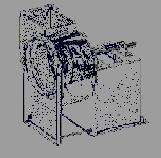N.B. It is important that rotor balancing be performed by an experienced rotating machinery specialist. |
|
The following describes the procedure for performing single or two plane balancing. The data is used in a balancing program for calculating the required balancing weight and position for attaching a balancing mass to the rotor. The vibration magnitude and phase angle must be obtained using a
suitable balancing machine. For recommended balancing limits, see international standard: ISO-3945. |
 |
|
|
Single Plane Balancing Procedure |
|
|
|
|
1. |
Run the machine and record the initial rotor vibration and phase angle. |
|
|
|
|
2. |
Stop the machine and firmly attach a small Trial Weight to the rotor. Record the Trial Weigh mass and position. (Ensure that the Trial Weight is firmly attached to the rotor. It is a serious safety risk if the Trial Weight is not firmly attached and flies off while running the machine). |
|
|
|
|
3. |
Run the machine and record the new rotor vibration and phase angle. |
|
|
|
|
4. |
Stop the machine and remove the Trial Weight. |
|
|
|
|
5. |
Input the data obtained from the 3 steps above in a single plane balancing program to calculate the required balancing weight and position. |
|
|
|
|
6. |
Firmly attach a balancing weight of the required mass to the calculated position on the rotor. |
|
|
|
|
7. |
Run the machine and re-measure vibration. If required, perform a trim balance. |
|
|
|
Two Plane Balancing Procedure |
|
|
|
|
1. |
Measure and record the initial rotor vibration and phase angle on both bearings. |
|
|
|
|
2. |
Stop the machine and attach a small Trial Weight to plane 1 of the rotor. Record the trial weigh mass and position. (Ensure that the Trial Weight is firmly attached to the rotor. It is a serious safety risk if the Trial Weight is not firmly attached and flies off while running the machine). |
|
|
|
|
3. |
Run the machine and record the new rotor vibration and phase angle on both bearings. |
|
|
|
|
4. |
Stop the machine and remove the Trial Weight from plane 1. Attach a small Trial Weight to plane 2 of the rotor. Record the trial weigh mass and position. (Ensure that the Trial Weight is firmly attached to the rotor. It is a serious safety risk if the Trial Weight is not firmly attached and flies off while
running the machine). |
|
5. |
Run the machine and record the new rotor vibration and phase angle on both bearings. |
|
|
|
|
6. |
Stop the machine and remove the Trial Weight from plane 2. |
|
|
|
|
7. |
Input the data obtained from the 3 steps above in a two plane balancing program to calculate the required balancing weights and positions. |
|
|
|
|
8. |
Firmly attach balancing weights of the required mass to the calculated positions on planes 1 and 2 of the rotor. (Ensure that the Balancing weights are firmly attached to the rotor. It is a serious safety risk if a Balancing Weight is not firmly attached and flies off while running the machine). |
|
|
|
|
9. |
Run the machine and re-measure vibration. If required, perform a trim balance. |
|
|